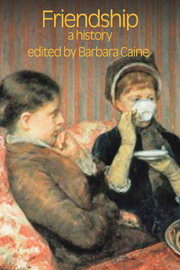Book contents
- Frontmatter
- Contents
- Preface
- Introduction
- 1 The Classical Ideals of Friendship
- 2 Cicero on Friendship
- 3 The Latin West
- 4 Renaissance Friendships: Traditional Truths, New and Dissenting Voices
- 5 From Christian Friendship to Secular Sentimentality: Enlightenment Re-evaluations
- 6 Taking up the Pen: Women and the Writing of Friendship
- 7 Class, Sex and Friendship: The Long Nineteenth Century
- 8 New Worlds of Friendship: The Early Twentieth Century
- 9 The Importance of Friends: The Most Recent Past
- Bibliography
- Index
7 - Class, Sex and Friendship: The Long Nineteenth Century
- Frontmatter
- Contents
- Preface
- Introduction
- 1 The Classical Ideals of Friendship
- 2 Cicero on Friendship
- 3 The Latin West
- 4 Renaissance Friendships: Traditional Truths, New and Dissenting Voices
- 5 From Christian Friendship to Secular Sentimentality: Enlightenment Re-evaluations
- 6 Taking up the Pen: Women and the Writing of Friendship
- 7 Class, Sex and Friendship: The Long Nineteenth Century
- 8 New Worlds of Friendship: The Early Twentieth Century
- 9 The Importance of Friends: The Most Recent Past
- Bibliography
- Index
Summary
Introduction
There is no sharp and sudden break between the eighteenth and the nineteenth centuries in ideas about or discussions of friendship. On the contrary, the continuing importance of many of the ideas about sexual difference, separate spheres and family life which had been so important in the Enlightenment, and of the stress on the place of sentiment and emotion in the arts, literature and general outlook associated with Romanticism, ensured that there were marked continuities at least until World War I. Some of these developments seem to have become more widely diffused. Thus, for example, a number of recent historians have written about the importance of intimate same-sex friendships between both men and women in the nineteenth century in a range of countries, including Germany, Britain, Russia and the United States. There was also a strong sense of the overlap between family and friends in the value accorded close and intimate familial bonds, evident not only in the ideal of companionate marriages, but also in close sibling ties which were often seen as providing lifelong forms of companionship and support. The ties of sisters were of particular interest to some English women novelists, but fraternal bonds and those between brothers and sisters were of great moment too.
- Type
- Chapter
- Information
- FriendshipA History, pp. 223 - 278Publisher: Acumen PublishingPrint publication year: 2009



